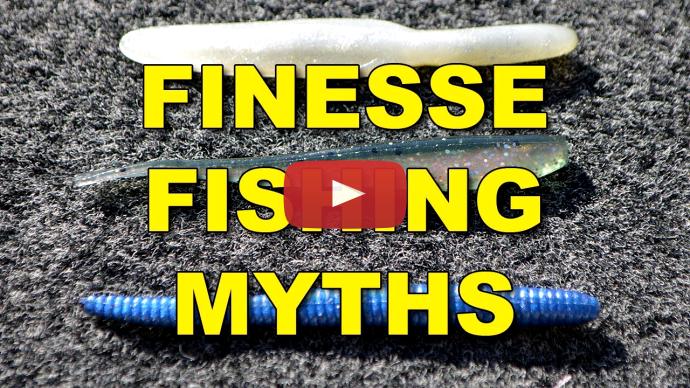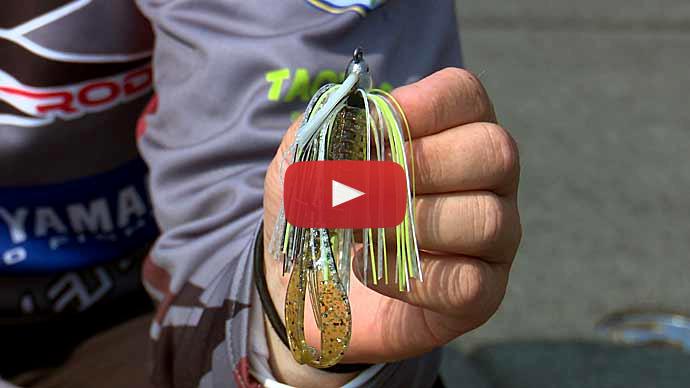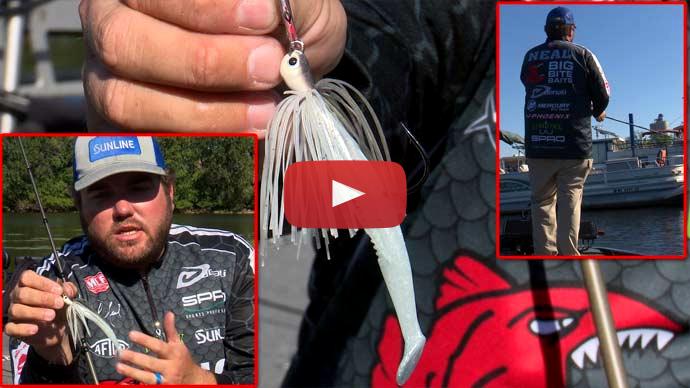Hey guys, Michael Neal here with Bass Resource. I wanna talk about finesse gear in the fall. And the fall is really a tricky time of year no matter what part of the country you're in, you've got fish that are really spread out. You've still got some that are out deep in their summer haunts, and you've got some that have moved up chasing bait fish, getting ready for the winter, trying to feed up, and it's just a place where they're all over the map.
So, you've got to pick an area and really just pick it apart. And that's when I say that, you know, it sounds kind of counterintuitive that you want to finesse fish, but really you can finesse fish a lot quicker than you really think you can. And by doing that, you just make a cast, let it fall to the bottom, move it just a little bit, and see if there you went by a fish on the way to the bottom or landed on his head, reel it in, throw it again.
So, that's really the way that I like to fish a shaky head in the fall. And, you know, a key place to this is docks. So, if you feel like the fish are on the main lake points if they're in the backs, you figure out which kind of docks that they're on and just cast this to the shadiest spots that you can find, the corner posts, and your high percentage areas. But don't worry about fishing all the way back to the boat.
And now if you get around a bunch of fish, that's one thing you know, you can slow down a little bit more, but to find them, figure out the pattern, just let your shaky head fall down, spiral down. And most of your bites, probably 75% of your bites are gonna come on the fall. So, just make this bait fall down through there as many times as you can.
And in the fall of the year, they're really keyed in on baitfish, you know, your shad and things like that. So, I like this smoke purple worm. This is a Sentsation Skinny Stick from Big Bite. It's just a five-inch bait. It's a really good bait fish imitator for that time of year. You don't want something that's gonna be bright. By this time of year, you know, the fish have really been pressured a lot from the spring all the way through the summertime and now getting into the fall. So, you wanna match whatever they're chasing as much as you can, and typically that's gonna be shad, smoke purple is gonna be the way to go in this lineup with a Skinny Stick.
With the line set up. I like 10-pound SX1 Sunline to an 8-pound sun Sunline Shooter leader. And you, you know, your leader length is really a lot of personal preference. I tie an FG knot, so I probably have, you know, about a 20-foot leader on there at all times. I could fish two or three days without having to retie, but if you're a guy that hasn't figured out how to tie that FG yet, if you wanna tie an Alberto somewhere in that 6-foot range is really all you need.
If the fish is going to be looking at your bait or coming to eat it, they're not going be worried about what's 6 foot above there. So, just keep your good fluorocarbon leader. You're gonna have less stretch, more sensitivity, you're gonna know those fish, get it.
And for a rod, this is my go-to shaky head rod, 365 days a year. It's the Denali N3, the 7-foot medium action spinning rod, and it's long enough to where, you know, if you're fishing those deeper points or your transition banks back in the creeks, which is also a fall spot where the fish are going to that last deep water waiting to go back and chase bait fish in the back to where you can make accurate cast around things on the bank, your laydowns. You can skip under the overhanging trees under boat docks, put it right beside that dock cable, right beside that dock post where that fish is gonna be sitting. You don't want too long of a rod to where you can't make accurate casts, but you also don't want a super short rod to where you can't make those long casts if you want to, and fish it a little bit deeper, a little bit further off the bank.
So, shaky head, you know, is a great way to go. And as they start schooling and you aren't looking for something else to throw in them, it really doesn't make sense. But fishing baits on the bottom is a great way to go when the fish are actually up and schooling. Shaky head's a great option for that, but you know, probably better than that is a drop shot.
And you can really vary your weight with this, so if you're fishing for schooling fish, you know, up in the back of a creek, and they may be 2 or 3-foot deep, then you could go with a super lightweight, you know, like a 8th or a 16th and just throw this in those schooling fish either with a Skinny Stick or, you know, even a minnow imitating bait fish style bait, that's also a great way to go in the fall. I really don't use it on the drop shot in the spring or summer as much as I do in the fall just because I'm trying to mimic those bait fish as closely as I can because they get so keyed in on it, so in tune with what those bait fish look like, that you really want to get that in there.
And a lot of people think that you have to throw topwaters or things like that to get those fish to react. But in reality, a lot of your bigger fish too are actually underneath the fish that are up on top schooling. So, if you're on a lake where, you know, they're schooling over a 20 foot of water, you're gonna have a bunch of smaller fish up top chasing, but those bigger fish will sit underneath them, and wait on some of those dying shad. That's a smaller fish that really run and beat up to fall down below 'em.
And that's when this drop shot's really gonna shine. You pitch it in there to those schooling fish, it's going to sink fast enough through those up on top to where you're gonna get down to that second layer. And it's hard to get a lot of baits down that deep, you know, a jerk bait, or things like that. They're going to get eaten by one of those smaller fish before they actually have time to get down there. So, something with a vertical drop like this drop shot is gonna be the way to go.
And those schooling fish can be really finicky, and a lot of times you have to make a really long cast to 'em. And that's where a rod really makes up a big difference. So, I like a 7-foot-6 medium action. This is Denali Kovert, I had a big hand in designing this rod. It's kind of labeled as my offshore spinning rod, but if you're chasing those schooling fish, you have to be able to get to 'em, and you have to get on 'em as soon as they're there because they're constantly moving.
That's the thing about the fall time of the year, is they're never sitting still hardly, they're constantly moving around chasing bait fish. They may stop for a few minutes and feed. But again, going back to what I said at the beginning, you wanna make as many casts as you can to as many different targets, as many different places, and try and find one of those fish that are actively moving, actively swimming, looking for that next meal.
And with the line again, same setup here, 10-pound SX1, 8-pound Sunline Shooter leader, Sniper works great also, or even Assassin or Super, but to me, the Shooter's a lot more abrasion resistance, and you can catch a lot more fish on it without having to retie. And that's a big deal to me, especially when you're chasing those schoolers around is you don't wanna be wasting any time having to retie or things like that.
So, you know, recapping shaky head around targets, dock posts, shade, transition banks back in the back. Drop shot around more of those open water fish where you're having to see the baitfish come up.
That's a big key a lot of the times too is be looking for the bait. Don't just be looking for the fish to come up schooling, look for a baitfish to fly out of the water. If you see one of 'em fly out of the water, they're probably coming to there. Don't just wait until you hear a big school of fish come up, a lot of times what you see on top is just a small portion of what's going on under the water. So, just any kind of activity you see.
Fishing grass lines is also great in the fall, that's something that they use to corral the bait. Anything they can corral bait on, whether it's sea walls, grass lines, riprap banks, things like that. That's why they're so common for fish to school on is because they have a great way to push that bait up there, corral it to where they can get to it.
You know, smallmouth and spots are a lot more aggressive. They tend to school in open water a lot more than largemouth do. Largemouth still will, but it's harder for them to catch and corral that bait without something to push it against.
So, when you're out there in the fall, two things to remember, keep moving, look for the active fish. Look for where they can corral bait, and completely match the hatch. The closer you can get to the size, color, and imitation of those baitfish that time of year, the more bass you're gonna catch. Check out these tips and more from bassresource.com.
BassResource may receive a portion of revenues if you make a purchase using a link above.



